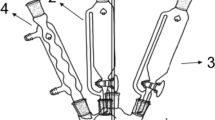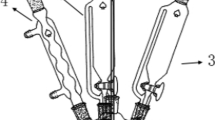Abstract
Stable, coagulum free fluoro-silicone-acrylic latex (FSAL) of methyl methacrylate (MMA)-co-butyl acrylate (BA)-co-Zonyl TM-hyb-Polydimethylsiloxane (PDMS) is prepared through mini-emulsion polymerization. Apart from this, three more latexes/emulsions acrylic latex (AL) of methyl methacrylate (MMA)-co-butyl acrylate (BA), silicone-acrylic latex (SAL) of methyl methacrylate (MMA)-co-butyl acrylate (BA)-hyb- PDMS, and fluoro acrylic latex (FAL) of methyl methacrylate (MMA)-co-butyl acrylate (BA)-co-Zonyl TM are prepared for systematic understanding of the preparation and properties of the emulsions. The emulsions are prepared with almost uniform size of monomer droplets (mini-emulsions). The prepared latexes were characterized by IR, C13 NMR and 1H NMR. A systematic understanding of the effect of initial droplet size on final latex particle, the properties of the latex particles such as swelling ratio, MFFT, contact angle, distribution of particle size, rheological behavior, DSC/DMA thermograms, SEM images of the films and film topography are reported. The fluoro-silicone-acrylic latex (FSAL) exhibit, stable, low MFFT, narrow particle size distribution, and high contact angle for water, and hence it can be a great candidate as a hydrophobic binder in coating products.








Similar content being viewed by others
References
van Herk AM, Landfester K (2010) Hybrid latex particles: preparation with (mini)emulsion polymerization. Springer, 9
Matyjaszewski K, Davis TP (2002) Hand book of radical polymerization. Wiley, USA, p 305
Nakaya T (1996) Development of a staining preventive coating for architecture. Prog Org Coat 27:173–180
Takayanagi T, Yamabe M (2000) Progress of fluoropolymers on coating applications development of mineral spirit soluble polymer and aqueous dispersion. Prog Org Coat 40:185–190
Qu A, Wen X, Pi P, Cheng J, Yang Z (2008) Synthesis and characterization of hybrid fluoro-emulsion based on silica/copolymer composite particles. Polym Int 57:1287–1294
Landfester K, Rothe R, Antonietti M (2002) Convenient synthesis of fluorinated latexes and core-shell structures by miniemulsion polymerization. Macromolecules 35:1658–1662
Otaka A, Miura M, Tsuchiya K, Ogino K (2008) Hydrophobic surface construction by phase-seperation of fluorinated block copolymer for immersion lithography. J Photopolym Sci Technol 21:679–684
Cengiz U, Gengec NA, Erbil HY (2013) Surface characterization of flat and rough films of perfluoromethacrylate-methylmethacrylate statistical copolymers synthesized in CO2-expanded monomers. Colloid Polym Sci 291:641–652
Cui X, Gao Y, Zhong S, Zheng Z, Cheng Y, Wang H (2012) Synthesis and surface properties of semi-interpenetrating fluorine-containing polyacrylate and epoxy resin networks. J Polym Res 19:9832–9838
Landfester K, Pawelzik U, Antonietti M (2005) Polydimethylsiloxane latexes and copolymers by polymerization and polyaddition in miniemulsion. Polymer 46:9892–9898
Tsai M-F, Lee Y-D, Long YC (2000) Synthesis of a poldimethylsiloxane-block-hydroxyl grafted acrylate prepolymer copolymer to improve the adhesion between silicone rubber and polyurethane by induced surface reconstruction. J Polym Res 7:73–79
Bas S, Soucek MD (2012) Optimization and composition of polysiloxane acrylic hybrid latex synthesis methods. J Polym Res 19:9907–9917
Butts M, Cella J, Wood CD, Gillette G, Kerboua R, Leman J, Lewis L, Rajaraman S, Rubinsztajn S, Schattenmann F, Stein J, Wengrovius J, Wicht D (2003) Silicones. In: Encyclopedia of polymer science and technology, 2nd edn. Wiley, New York
Nzudie DT, Juhue D, Corpart J (2004) Polymers fluorinated by polymerization in mini-emulsion. US Patent 6774176:B1
Landfester K, Bechthold N, Forster S, Antonietti M (1999) Evidence for the preservation of the particle identity in miniemulsion polymerization. Macromol Rapid Commun 20:81–84
Ostwald W (1900) Uber die vermeintliche lsomerie des roten und gelben Quecksilberoxsyds und die Oberflachenspannung festter Korper, Z. Phys Chem, Stochiometrie Verwandschaftlehre 34:495–503
Chern C, Chen T (1998) Effect of Ostwald ripening on styrene miniemulsion stabilized by reactive cosurfactants. Colloids Surf A 138:65–74
Bechthold N, Landfester K (2000) Kinetics of miniemulsion polymerization as revealed by calorimetry. Macromolecules 33:4682–4689
Wu XQ, Schork FJ, Gooch JW (1999) Hybrid miniemulsion polymerization of acrylic/alkyd systems and characterization of the resulting polymers. J Polym Sci Polym Chem 37:4159–4168
Wang ST, Schork FJ, Poehlein GW, Gooch JW (1996) Emulsion and miniemulsion copolymerization of acrylic monomers in the presence of alkyd resin. J Appl Polym Sci 60:2069–2076
Tsavalas J, Gooch J, Schork F (2000) Water-based crosslinkable coatings via miniemulsion polymerization of acrylic monomers in the presence of unsaturated polyester resin. J Appl Polym Sci 75:916–927
Gooch J, Dong H, Schork F (2000) Waterborne oil-modified polyurethane coatings via hybrid miniemulsion polymerization. J Appl Polym Sci 76:105–114
Li M, Daniels E, Dimonie V, Sudol E, El Aasser M (2005) Preparation of polyurethane/acrylic hybrid nanoparticles via a miniemulsion polymerization process. Macromolecules 38:4183–4192
Jeong P, Dimonie V, Daniels E, El-Aasser M (2003) Direct miniemulsification of kraton rubber/styrene solution. I. Effect of Manton–Gaulin homogenizer, sonifier, and membrane filtration. J Appl Polym Sci 89:451–464
Kawahara H, Goto T, Ohnishi K, Ogura H, Kage H, Matsuno Y (2001) Preparation of epoxy resin/acrylic composite latexes by miniemulsion polymerization method. J Appl Polym Sci 81:128–133
Chen Y, Zhang C, Chen Yanjun X (2006) Emulsifier-free latex of fluorinated acrylate copolymer. Eur Polym J 42(3):694–701
Cheng S, Chen Y, Chen Z (2002) Core–shell latex containing fluorinated polymer rich in shell. J Appl Polym Sci 85:1147–1153
Lin M, Chu F, Guyot A, Putaux JL, Lami EB (2005) Silicone–polyacrylate composite latex particles. Particles formation and film properties. Polymer 46(4):1331–1337
He WD, Cao CT, Pan CY (1996) Formation mechanism of silicone rubber particles with core-shell structure by seeded emulsion polymerization. J Appl Polym Sci 61(2):383–388
Rodríguez R, Barandiaran MJ, Asua JM (2008) Polymerization strategies to overcome limiting monomer conversion in silicone-acrylic miniemulsion polymerization. Polymer 49:691–696
Oshibe Y, Ohmura H, Yamamoto T, Kasemura T (1994) Adhesion properties of acrylic copolymers modified with Si-containing copolymer. J Adhes 47:1–3
Ahmad NM, Heatley F, Lovell PA (1998) Chain transfer to polymer in free-radical solution polymerization of n-butyl acrylate studied by NMR spectroscopy. Macromolecules 31:2822–2827
Acknowledgment
Author would like to thank to B.P. Mallik, Mr. Tapan Dhar and Dr. Biswaranjan Nayak for their kind support. Our thanks are also due to SICART and analytical lab (Asian Paints Limited) who did the characterizations in time.
Author information
Authors and Affiliations
Corresponding authors
Electronic supplementary material
Below is the link to the electronic supplementary material.
ESM 1
(DOC 624 kb)
Rights and permissions
About this article
Cite this article
Phukon, N., Haramagatti, C.R., Jha, P. et al. Hybrid copolymer latex of MMA-BA-zonyl TM-PDMS by mini-emulsion polymerization. J Polym Res 20, 268 (2013). https://doi.org/10.1007/s10965-013-0268-4
Received:
Accepted:
Published:
DOI: https://doi.org/10.1007/s10965-013-0268-4




